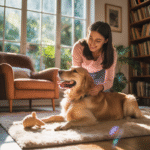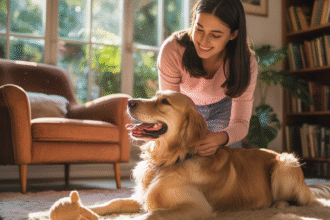The Benefits of Regular Exercise for Dogs and Their Owners: A Path to Mutual Well-Being
The daily walk with your dog might seem like just another item on your to-do list. Still, regular exercise with your canine companion offers profound benefits beyond simply burning off your pup’s excess energy. When you commit to regular physical activity with your dog, you’re investing in both your physical health and mental well-being, as well as the strength of your bond with your dog.
Physical Health Benefits for Dogs
Regular exercise is the cornerstone of canine health maintenance. Dogs who engage in consistent physical activity maintain healthier body weights, reducing their risk of obesity-related conditions such as diabetes, arthritis, and heart disease. The impact on joint health proves particularly significant—regular, moderate exercise helps maintain cartilage health and muscle strength, supporting joints throughout your dog’s life. This becomes especially important as dogs age, when maintaining mobility can significantly impact quality of life.
Exercise also plays a crucial role in digestive health. Regular movement promotes healthy digestion and can help prevent constipation, while physical activity helps regulate metabolism. Dogs who exercise regularly often experience fewer gastrointestinal issues and maintain more consistent eating patterns. Additionally, the cardiovascular benefits mirror those seen in humans: improved heart health, better circulation, and increased stamina, allowing dogs to enjoy activities well into their senior years.
Regular exercise also boosts the immune system. Active dogs typically show stronger immune responses and recover more quickly from minor illnesses. Outdoor exposure that often accompanies exercise provides additional benefits through vitamin D synthesis from sunlight and exposure to various environmental elements that can help build a robust immune system.
Mental and Behavioral Advantages for Dogs
Perhaps equally important as the physical benefits, regular exercise profoundly impacts canine mental health and behavior. A tired dog is a good dog—physical activity helps channel energy that might otherwise manifest as destructive behaviors like excessive barking, chewing, or digging. Dogs with adequate exercise outlets show reduced anxiety levels and fewer stress-related behaviors.
Mental stimulation accompanies physical exercise, particularly when walks involve new routes, different terrains, or opportunities for exploration. This environmental enrichment helps prevent cognitive decline in older dogs and keeps younger dogs mentally sharp. The variety of smells, sights, and sounds encountered during outdoor exercise provides crucial sensory experiences that indoor environments cannot replicate.
Exercise also improves sleep quality for dogs. Just as humans sleep better after physical activity, dogs who exercise regularly develop healthier sleep patterns, leading to better overall behavior and mood regulation. This creates a positive cycle where well-rested dogs are more receptive to training and social interactions.
Health Benefits for Dog Owners
The benefits of regular dog exercise extend powerfully to human companions. Dog owners who walk their pets regularly often meet or exceed recommended daily physical activity levels without needing to set aside dedicated gym time. This consistent, moderate exercise contributes to cardiovascular health, weight management, and improved overall fitness. Studies have shown that dog owners walk more than non-dog owners, accumulating significant health benefits over time.
The mental health advantages for owners prove equally compelling. Regular outdoor exercise with a dog provides natural stress relief and has been linked to reduced symptoms of depression and anxiety. Daily walks create structure and purpose, particularly beneficial for individuals working from home or those prone to sedentary lifestyles. The outdoor exposure increases vitamin D production and provides the mood-boosting effects of fresh air and natural light.
Blood pressure reduction represents another significant benefit for dog owners who exercise regularly with their pets. The combination of physical activity and the calming presence of a canine companion creates an ideal environment for cardiovascular health improvement. Some studies have even suggested that dog owners have better survival rates following heart attacks, potentially linked to the increased physical activity and stress reduction associated with dog ownership.
Strengthening the Human-Dog Bond
Regular exercise together creates countless opportunities for bonding between dogs and their owners. Shared activities build trust and communication, strengthening the relationship in ways that sedentary interactions cannot achieve. Dogs learn to read their owners’ body language and verbal cues more effectively during active engagement, while owners become more attuned to their dogs’ needs and behaviors.
Training opportunities naturally arise during exercise sessions. Whether practicing recall at the dog park, working on leash manners during walks, or incorporating obedience commands into play sessions, exercise time doubles as training time. This consistent reinforcement in varied environments helps dogs generalize their training more effectively than indoor-only practice.
The shared experiences created through regular exercise—discovering new trails, meeting other dogs and owners, overcoming challenges together—form the foundation of a deep, lasting bond. These positive associations strengthen the dog’s attachment to its owner and increase its responsiveness to commands and guidance.
Social Benefits for Both Species
Regular exercise provides crucial socialization opportunities, particularly in public spaces like dog parks or walking trails. Dogs learn appropriate interaction skills with other dogs and humans, reducing fear and aggression while building confidence. Well-socialized dogs are generally happier, more adaptable, and easier to manage.
For owners, dog walking creates natural opportunities for social interaction. Dog parks and walking routes often lead to conversations with other dog owners, potentially forming friendships based on shared interests. This social aspect proves particularly valuable for individuals who might otherwise struggle with social isolation, such as retirees, remote workers, or people new to an area. The dog serves as a natural conversation starter and common ground for connection.
Community engagement often follows from regular dog exercise routines. Many neighborhoods have informal dog walking groups, and participating in these activities helps build community connections and support networks. Some areas organize dog-friendly events, charity walks, or training classes that further expand social opportunities for both dogs and owners.
Practical Considerations for Implementation
One thing is understanding the importance of exercise; implementing a sustainable routine requires practical planning. The amount and type of exercise needed vary significantly based on breed, age, health status, and individual energy levels. High-energy breeds like Border Collies or Labrador Retrievers may require two hours or more of activity daily. In contrast, smaller or less active breeds might thrive with 30-45 minutes of moderate exercise.
Age considerations play a crucial role in exercise planning. Puppies need frequent but shorter exercise sessions to avoid damaging developing joints, while senior dogs benefit from gentler, more frequent activities that maintain mobility without causing strain. Dogs with health conditions require modified exercise plans developed in consultation with veterinarians.
Weather presents another practical consideration. Extreme temperatures require schedule adjustments and safety precautions. Hot weather demands early morning or evening exercise to avoid heat stroke, while cold weather might necessitate shorter, more frequent outings with appropriate protection for sensitive paw pads. Having indoor exercise alternatives—such as training sessions, puzzle toys, or indoor agility courses—ensures consistency regardless of weather conditions.
Creating variety in exercise routines prevents boredom for both dogs and owners. Alternating between walks, hikes, swimming (for water-loving breeds), fetch games, and agility training keeps exercise engaging and works different muscle groups. This variety also helps prevent repetitive strain injuries from doing the same activity exclusively.
Overcoming Common Obstacles
Time constraints represent the most common barrier to regular dog exercise. However, creative solutions exist: breaking exercise into multiple shorter sessions throughout the day, incorporating dogs into existing activities like jogging or hiking, or utilizing dog daycare or professional dog walkers when schedules become overwhelming. Remember that even short, consistent exercise sessions provide more benefit than sporadic, lengthy ones.
Physical limitations of owners need not prevent dogs from getting adequate exercise. Those unable to walk long distances might focus on games like fetch that allow the dog to run while the owner remains relatively stationary. Swimming provides excellent low-impact exercise for both dogs and owners with joint issues. Mobility aids, adaptive equipment, or partnering with more mobile family members or friends can ensure dogs receive necessary activity.
Behavioral challenges during exercise, such as leash pulling or reactivity to other dogs, often discourage regular outings. However, these issues typically improve with consistent, structured exercise and training. Working with professional trainers or attending group classes can transform exercise from a struggle into an enjoyable activity for both parties.
Long-Term Perspectives
The investment in regular exercise pays dividends throughout a dog’s life. Dogs who maintain consistent activity levels from youth through their senior years typically enjoy longer, healthier lives with fewer chronic conditions. The preventive health benefits—maintaining healthy weight, joint function, and cardiovascular health—far outweigh the time investment required for regular exercise.
For owners, establishing an exercise routine with a dog often leads to lasting lifestyle changes. Many people credit their dogs with helping them become more active, lose weight, or maintain fitness levels they might not have achieved independently. The accountability of a dog’s exercise needs provides powerful motivation for maintaining personal fitness routines.
The memories created through years of shared adventures—morning walks, weekend hikes, beach runs—become treasured parts of the human-dog relationship. These experiences enrich both lives in ways that extend far beyond the immediate physical and mental health benefits.
Conclusion
Regular exercise with your dog represents one of the most mutually beneficial activities you can share. The physical health improvements, mental well-being enhancements, strengthened bond, and social opportunities create a compelling case for prioritizing daily activity. While obstacles exist, creative solutions and the understanding that any exercise is better than none can help establish sustainable routines.
The beauty of exercising with your dog lies in its simplicity—no expensive equipment or gym memberships required, just time together exploring the world. Whether it’s a leisurely neighborhood stroll or an adventurous mountain hike, every step together strengthens bodies, minds, and the irreplaceable bond between humans and canines. In prioritizing regular exercise with your dog, you’re choosing health, happiness, and connection for both of you—a decision that will enhance your lives for years to come.




